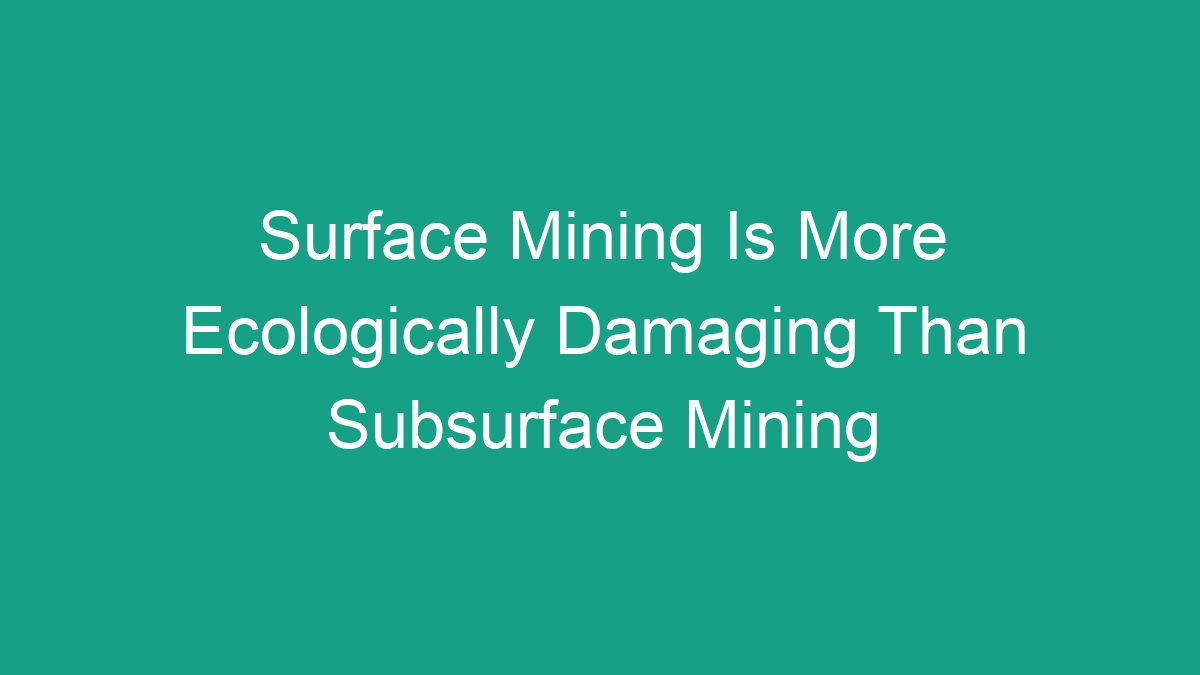
Introduction
Mining has been a critical part of human civilization for centuries, providing us with valuable resources such as minerals, ores, and fossil fuels. However, the methods used to extract these resources can have significant ecological impacts. Surface mining and subsurface mining are two primary methods used to access these valuable resources, and there is an ongoing debate about which method is more ecologically damaging. In this article, we will examine the environmental impacts of both surface mining and subsurface mining, and discuss why surface mining is generally considered to be more harmful to the environment.
Surface Mining: Environmental Impact
Surface mining, also known as open-pit mining or strip mining, involves removing the topsoil and rock above the mineral deposit. It is commonly used for coal and various metallic ores. The process begins with the removal of vegetation and soil, exposing the mineral deposit. This process can result in the destruction of the natural habitat for many species, leading to loss of biodiversity. Furthermore, the exposed rock and soil can erode, leading to sedimentation and pollution of nearby water bodies, such as rivers and streams. Additionally, the huge open pits created by surface mining can alter the landscape and lead to changes in the local hydrology. This alteration can disrupt the flow of groundwater and affect local water sources. The resulting landscape can also lead to an increase in soil erosion and sedimentation.
In addition, surface mining often requires massive amounts of water for processing and dust suppression. This water usage can lead to the depletion of local water sources, impacting both human communities and local wildlife. The process of extracting and processing the valuable minerals also leads to the release of potentially hazardous chemicals and heavy metals into the environment. These pollutants can contaminate nearby water sources and soil, leading to long-term ecological damage and potential health risks for nearby communities.
Subsurface Mining: Environmental Impact
Subsurface mining, also known as underground mining, involves accessing the mineral deposit by creating tunnels and shafts. This method is commonly used for coal, diamonds, and other valuable resources. While subsurface mining also has environmental impacts, they are generally less severe than those associated with surface mining. One of the primary environmental concerns with subsurface mining is the potential for groundwater contamination. The process of digging tunnels and creating shafts can disrupt natural aquifers and lead to the release of pollutants into the groundwater. However, with proper planning and environmental regulations, these impacts can be minimized.
Another concern with subsurface mining is the potential for surface subsidence. As underground voids are created during the extraction process, the overlying land can sink, leading to the potential for damage to infrastructure and natural habitats. However, modern engineering techniques and regulations are designed to minimize the potential for surface subsidence and mitigate its impacts.
Comparison of Environmental Impact
When comparing the environmental impact of surface mining and subsurface mining, it becomes clear that surface mining is generally more ecologically damaging than subsurface mining. The destruction of habitats, alteration of landscapes, and contamination of water sources associated with surface mining are often more severe and long-lasting than the impacts of subsurface mining. The need for massive land clearing, water usage, and the release of pollutants into the environment make surface mining a more significant threat to the environment.
Regulations and Mitigation Measures
Both surface mining and subsurface mining are subject to a range of environmental regulations designed to minimize their ecological impacts. These regulations often include requirements for reclamation and restoration of mined sites, the management of water usage and pollution, and the monitoring and control of potential air pollution. While these regulations have helped to mitigate some of the environmental impacts of mining activities, the scale of disturbance associated with surface mining makes it more challenging to fully mitigate its ecological impacts. The creation of massive open pits and the removal of vegetation and topsoil can result in permanent alterations to the landscape that are difficult to fully restore.
Conclusion
In conclusion, surface mining is more ecologically damaging than subsurface mining due to the scale of disturbance and the severity of its impacts on natural habitats, landscapes, and water sources. While both methods have environmental impacts, surface mining’s extensive land clearing, water usage, and release of pollutants make it a more significant threat to the environment. As global demand for minerals, ores, and fossil fuels continues to grow, it is essential to consider the environmental impacts of these extraction methods and work towards promoting sustainable mining practices and minimizing ecological damage.




